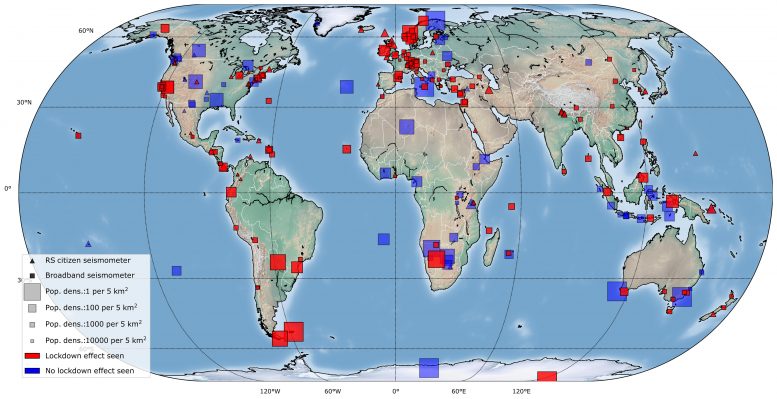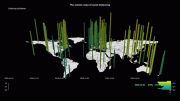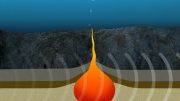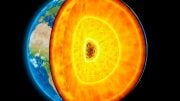
Locations of the 268 global seismic stations were analyzed in the research. Lockdown effects are observed (red) at 185 out of 268 stations. Symbol size is scaled by the inverse of population density to emphasize stations located in remote areas. Credit: Lecocqet al.
Global COVID-19 “lockdown” measures — the quarantines, physical isolation, travel restrictions, and widespread closures of services and industries that countries around the world have implemented in 2020 — resulted in a months-long reduction in global seismic noise by up to 50%, representing the longest and most prominent global seismic noise reduction in recorded history.
Like earthquakes and other geophysical processes and events, humans are a major source of seismic signals detected by seismometers worldwide. Everyday human activity — from our involvement in industrial processes and construction projects to our raucous outbursts at football stadiums — generates vibrations in the earth that are recorded as a near-continuous stream of high-frequency seismic waves.
In general, this seismic noise closely tracks human behavior; it’s typically stronger during the day than at night and weaker on weekends and holidays than it is on typical weekdays. However, the nature of global anthropogenic seismic noise remains relatively understudied. What’s more, the complex high-frequency background signal it produces limits the ability of seismic warning networks to detect the more discrete signals associated with local geologic hazards like earthquakes.
This year, disruptions to human activity during various COVID-19 emergency measures presented a unique opportunity to evaluate human-induced seismicity.
Thomas Lecocq and colleagues compiled seismic observations from 268 seismic stations around the world and found a near-global reduction in high-frequency seismic ambient noise, which began in China in late January 2020 and was followed by the same phenomenon in Europe and the rest of the world in March to April. “The noise level we observe during lockdowns lasted longer and was often quieter than the Christmas to New Year period,” the authors write. The global spread of the quieting was closely correlated to when lockdown measures went into effect in countries around the world.
In total, global anthropogenic seismic noise dropped by as much as 50% from March to May.
Not only do the results help constrain the seismic impact of human activity and its unique signals, the “2020 seismic noise quiet period” allowed the researchers to detect subtle and often obscured seismic signals from subsurface sources, which could help disentangle anthropogenic noise and natural processes.
Finally, the research revealed that anthropogenic seismic wavefields affect larger areas than previously thought, a finding supported by the correlations with independent mobility data. In contrast to mobility data, though, publicly available data from existing seismometer networks has fewer potential privacy concerns. Thus, note the authors, it could be an alternative for near-real-time monitoring of anthropogenic activity patterns.
For more on this research, read COVID-19 Lockdowns Caused Earth Vibrations From Human Activity to Drop 50%.
Reference: “Global quieting of high-frequency seismic noise due to COVID-19 pandemic lockdown measures” by Thomas Lecocq, Stephen P. Hicks, Koen Van Noten, Kasper Van Wijk, Paula Koelemeijer, Raphael S. M. De Plaen, Frédérick Massin, Gregor Hillers, Robert E. Anthony, Maria-Theresia Apoloner, Mario Arroyo-Solórzano, Jelle D. Assink, Pinar Büyükakpinar, Andrea Cannata, Flavio Cannavo, Sebastian Carrasco, Corentin Caudron, Esteban J. Chaves, David G. Cornwell, David Craig, Olivier F. C. Den Ouden, Jordi Diaz, Stefanie Donner, Christos P. Evangelidis, Läslo Evers, Benoit Fauville, Gonzalo A. Fernandez, Dimitrios Giannopoulos, Steven J. Gibbons, Társilo Girona, Bogdan Grecu, Marc Grunberg, György Hetényi, Anna Horleston, Adolfo Inza, Jessica C. E. Irving, Mohammadreza Jamalreyhani, Alan Kafka, Mathijs R. Koymans, Celeste R. Labedz, Eric Larose, Nathaniel J. Lindsey, Mika Mckinnon, Tobias Megies, Meghan S. Miller, William Minarik, Louis Moresi, Víctor H. Márquez-Ramírez, Martin Möllhoff, Ian M. Nesbitt, Shankho Niyogi, Javier Ojeda, Adrien Oth, Simon Proud, Jay Pulli, Lise Retailleau, Annukka E. Rintamäki, Claudio Satriano, Martha K. Savage, Shahar Shani-Kadmiel, Reinoud Sleeman, Efthimios Sokos, Klaus Stammler, Alexander E. Stott, Shiba Subedi, Mathilde B. Sørensen, Taka’aki Taira, Mar Tapia, Fatih Turhan, Ben Van Der Pluijm, Mark Vanstone, Jerome Vergne, Tommi A. T. Vuorinen, Tristram Warren, Joachim Wassermann and Han Xiao, 23 July 2020, Science.
DOI: 10.1126/science.abd2438









Be the first to comment on "Drastic Reduction in Earth’s Seismic Background Noise Due to COVID-19 Lockdowns"